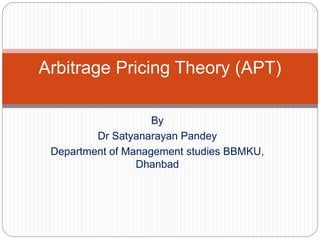
Arbitrage pricing theory (apt)
- 1. By Dr Satyanarayan Pandey Department of Management studies BBMKU, Dhanbad Arbitrage Pricing Theory (APT)
- 2. What is Arbitrage Pricing Theory (APT)? Arbitrage Pricing Theory (APT) is a well-known method of estimating the price of an asset. The theory assumes an asset's return is dependent on various factors- 1. Macroeconomic 2. Market 3. Security –specific factors
- 3. The General idea behind APT Two things can explain the expected return on a financial asset: 1) Macroeconomic/security-specific influences and 2) The asset's sensitivity to those influences. This relationship takes the form of the linear regression formula below.
- 4. Arbitrage Pricing Theory (APT) The arbitrage pricing theory, or APT, is a model of pricing that is based on the concept that an asset can have its returns predicted. To do so, the relationship between the asset and its common risk factors must be analyzed. APT was first created by Stephen Ross in 1976 to examine the influence of macroeconomic factors. That allows for the returns of a portfolio and the returns of specific asset to be predicted by examining the various variables that are independent within the relationship.
- 5. APT Formula APT is an alternative to the Capital Asset Pricing Model (CAPM). Stephen Ross developed the theory in 1976.The APT formula is: E(rj) = rf + bj1RP1 + bj2RP2 + bj3RP3 + bj4RP4 + ... + bjnRPn where: E(rj) = the asset's expected rate of return rf = the risk-free rate bj = the sensitivity of the asset's return to the particular factor RP = the risk premium associated with the particular factor
- 6. Security-Specific Influences There are an infinite number of security-specific influences for any given security including inflation, production measures, investor confidence, exchange rates, market indices or changes in interest rates. It is up to the analyst to decide which influences are relevant to the asset being analyzed.
- 7. Pricing Once the analyst derive the expected rate of return of asset from the APT theory he would decide the correct price of the asset. APT can be applied to portfolios as well as individual securities also. A portfolio can have exposure and sensitivities to certain kind of risk also.
- 8. Why does Arbitrage portfolio theory Matters? It is a revolutionary model It allow the users to analyze the security. It is used to identify that either security is undervalue or overvalued so can investors can get benefit through the information. It is useful in formation of portfolio as it provide information that whether portfolio is exposed to certain factor.
- 9. Advantages It has fewer restrictions. It allows for more sources of risk It does not specify specific factors. It allows for unanticipated changes It allows investors to find arbitrage opportunities.
- 10. Disadvantages It is customized than CAPM but difficult to apply. It generates a large amount of data. It requires risk sources to be accurate. It requires the portfolio to be examined singularly. It is not a guarantee of results.
- 11. THANKS
